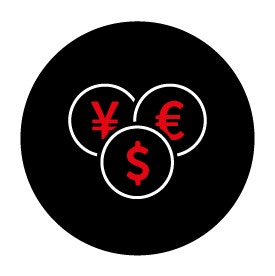
WHAT ARE ETFs AND HOW DO THEY WORK?
An exchange traded fund (ETF) is a basket of stocks or other assets that typically provides diversification compared to holding a single stock. Investors who own shares of ETFs don’t directly own the securities within the ETF. A wide range of ETFs is available across different markets such as stocks, bonds, and commodities. Explore what ETFs are, how they work, and what types of ETFs are offered.
WHAT IS AN EXCHANGE TRADED FUND (ETF)?
ETFs track the combined performance of the fund’s securities. As such, they are pooled investment assets that provide market participants with diversified exposure to a specific market, sector, industry, bonds, commodities, and more.
While ETFs generally emulate the price of various related assets – sometimes thousands in the case of stocks – there are some that track the price of a single underlying only. For example, Index ETFs are designed to replicate and track a benchmark index, like the S&P 500. The SPDR S&P 500 ETF Trust (SPY) may be one of the most well-known examples of an index ETF. It is 1/10th the size of SPX (Standard & Poor's 500 Index). On the other hand, the SPDR Gold Trust (GLD) is an example of tracking the price of a single underlying that was designed to track the value of gold in a tenth of an ounce.
Like mutual funds, ETFs offer market participants ownership in a professionally managed, diversified portfolio of investments. But unlike mutual funds, ETF shares trade like stocks on exchanges, and can be bought or sold throughout the trading day at fluctuating prices.
At tastytrade, you can trade an unlimited number of ETFs commission-free.1
HOW DO ETFs WORK?
ETFs are listed on centralized US exchanges where they can be bought and sold just like individual stocks. You can either speculate on their price performance or buy and hold shares. ETFs have ticker symbols just like stocks do. For example, Standard & Poor’s Depositary Receipts (SPDR) Gold Trust trades under ‘GLD’.
The price of an ETF is determined by the value of its underlying assets as well as typical price drivers like the marketplace’s supply and demand for the product.
WHY INVEST AND TRADE ETFs?
Trading and investing in any product is often driven by short-term and long-term financial goals, and each product comes with its own set of benefits and risks.
BENEFITS OF INVESTING AND TRADING ETFs
- Diversification: exposure to several assets in one investment
- Dividends: if the fund pays them (cash dividends or dividends can be reinvested)
- Tax benefits: capital gains are only incurred when the investment is sold as opposed to throughout its lifetime, which is common when utilizing mutual funds
- Easily attainable price data and no minimum investment requirements
RISKS OF INVESTING AND TRADING ETFs
- Illiquid ETFs make buying and selling more difficult
- Buying and selling ETFs can be capital intensive
- Traders and investors need to be able to withstand potential market volatility
- ETFs can close or stop trading
- Traders and investors need to be mindful of added costs such as management charges and additional fees
*On the tastytrade platform, you can follow the liquid ETFs watchlist or you can make your own ETF watchlist.
TYPES OF ETFs
Different types of ETFs offer diverse prospects. Explore some ETF types below.

1. SECTOR OR INDUSTRY ETFs
Sector or industry ETFs are funds that track the average performance of a group of similar stocks. They enable you to focus on specific sectors such as energy, technology or health care. Traders and investors often use sector ETFs to capitalize on significant developments in the economy. Another use is to hedge against risk where the outlook seems to suggest a high probability of the market moving against certain industry-specific positions.

2. BOND ETFs
Bond ETFs provide diversified exposure to bonds by issuers like government treasuries, municipalities, and public or private corporations. Investors typically use bond ETFs to receive regular income payments – through interest from the holdings – as they don’t have a maturity date like individual bonds.

3. INDEX ETFs
Index ETFs are designed to mimic the performance of corresponding benchmark indices by having similar (if not the same) holdings as the index itself. One such example of an index ETF is the S&P 500. Index ETFs are often categorized by market cap (share price times the number of shares outstanding), where large-cap encompasses a market value above $10 billion, mid-caps between $2 billion and $10 billion, and small-caps below $2 billion.

4. COMMODITY ETFs
There are two main types of ETFs related to the commodity space: commodity ETFs and commodity-linked ETFs. While the former focuses on the price action of a specific commodity such as crude oil, gold, natural gas, corn, etc., the latter is in relation to companies that operate within the specific commodity sectors such as energy, metals, and agriculture. Investing in raw material ETFs can offer either narrow or broad exposure. You can choose a fund that tracks the performance of a single commodity vs a basket of commodities.

5. CURRENCY ETFs
Currency ETFs seek to emulate the market prices of currency pairs. Like sector ETFs, currency ETFs can potentially be used to take advantage of changes in the economy. The currency market can be used to this effect in several ways, e.g. trading based on geopolitical events or hedging against positions with risks that are related to imports and exports.

6. BLOCKCHAIN & CRYPTO ETFs
Blockchain technology lays the foundation and infrastructure for cryptocurrencies to operate efficiently as a virtual currency. Blockchain ETFs track the performance of selections of companies with a considerable focus on blockchain technology within their operations. This thematic ETF type offers opportunities linked to the facilitation and development of how cryptocurrencies and decentralized finance (DeFi) work. Cryptocurrency ETFs track the performance of one or more digital tokens or cryptocurrencies. Unlike traditional ETFs where underlying assets are directly held, crypto ETFs can often be comprised of derivatives like crypto futures and options. Traders and investors should be aware of the volatility associated with cryptocurrencies.

7. INVERSE (SHORT) ETFs
Inverse ETFs3 are designed to generate gains when relevant stock prices decline. While commonly referred to as ETFs, technically, inverse ETFs are ETNs (exchange traded notes) that use bank debt and financing to hold short derivative contracts. So, when there is a decline in the market, an inverse ETF becomes profitable by increasing in price. Since a decline typically occurs in a bearish market, these investments are often meant for short-term trading. Traders and investors should be aware of the higher fees often associated with inverse ETFs when compared to traditional ETFs.

8. LEVERAGED ETFs
Leveraged ETFs3 are pooled investment vehicles that aim to mirror their underlyings’ performance and offer magnified exposure using financial derivatives. A 2x leveraged ETF, for instance, amplifies the trade or investment by using 2:1 leverage to double the exposure. Both potential profits and losses are magnified, which traders and investors should be mindful of when utilizing these products. Additionally, like inverse ETFs, fees and expense ratios are often higher in leveraged ETFs than in traditional ETFs.

9. INTERNATIONAL ETFs
In addition to the above, there are also international ETFs and country ETFs. International ETFs are typically designed to provide exposure to a particular region of the world, or a group of international companies with a similar profile.
For example, the iShares China Large Cap (FXI) is composed exclusively of large-cap companies with direct exposure to the Chinese economy. On the other hand, the iShares MSCI EAFE (EFA) is composed of large and mid-cap companies operating in a variety of developed countries around the world (excluding the US and Canada).
Country ETFs, as the name implies, are unique as they offer exposure to a specific country.
Some country ETFs track a specific foreign stock index, while others are designed to offer exposure to a unique investment theme within a specific country. Examples of country-specific ETFs include the iShares MSCI India ETF (INDA), the iShares MSCI South Korea ETF (EWY) and the VanEck Vietnam ETF (VNM).
HOW TO TRADE OR BUY AND INVEST IN ETFs
HOW TO TRADE ETFs
- Learn about ETFs and how to trade them
- Create a tastytrade account or log in
- Create a trading plan, timeframe, and a risk management strategy
- Choose an ETF and open your position
- Monitor and close your position
HOW TO BUY AND INVEST IN ETFs
- Learn about ETFs and how to buy and invest in them
- Create a tastytrade account or log in
- Define your investment goals, long-term timeframe, and risk tolerance
- Choose an ETF to invest in and open your position
- Monitor your position and sell your investment
ETFs VS MUTUAL FUNDS: WHAT ARE THE DIFFERENCES?
ETFs and mutual funds differ in several ways despite being run similarly. Here are some of the key differences between ETFs and mutual funds.
| ETFs | MUTUAL FUNDS |
|---|---|
Increased transparency in the sense that holdings are disclosed daily by the investment company | Holdings are disclosed on a monthly or quarterly basis |
Bought and sold on an exchange, like stocks | Orders are executed once at the end of each day at Net Asset Value (NAV) which is price per mutual fund share |
The share price is the minimum investment amount (excluding any additional fees) | Typically require a minimum investment value, which can vary in price based on the fund |
FAQs
An exchange traded fund (ETF) is an investment vehicle that tracks the performance of its underlying holdings. ETFs work by being bought and sold on a stock exchange. Trading ETFs allows for short-term speculation (bullish or bearish) on price movement or long-term investing by buying and holding.
Holding stock shares is having direct ownership of an individual company and holding ETF shares is having ownership of an investment company’s fund; Owning ETFs doesn’t involve actual ownership of any company stock within the fund. This explains why ETF investors wouldn’t have company voting rights when companies within the fund offer them to their shareholders. However, if an ETF holds a dividend paying stock in the fund, investors would likely receive a dividend. ETFs offer diversification with the fund’s basket of stocks or assets that an individual company stock doesn’t offer.
Here’s how ETFs and stocks compare on some other fronts:
ETFs | Stocks | |
| Traded on an exchange | X | X |
| Diversified exposure | X | |
| Commission-free1 | X | X |
| Short-selling2 | X | X |
| Limit and stop orders | X | X |
An ETF’s price is based on the average price of its holdings. This diversification may potentially make ETFs less volatile than individual underlying as the diversification may help balance the volatility to a more neutral level, which helps the price to be less reactive as well.
ETF prices are aligned to the value of its holdings using arbitrage mechanisms like continuous share issuance and redemption.
Investors make money from an ETF when they sell it for more than they paid for it. If the ETF tracks dividend-paying stocks, investors can also receive those dividends as income. Traders, on the other hand, can make money if their speculation of the market movement is correct, i.e. if they’re bullish and the ETF’s market price goes up, or if they’re bearish and the price falls.
ETFs also typically offer options, which means market participants have the full arsenal of options strategies at their disposal in the ETF universe as well. For example, traders can utilize vertical spreads in a country ETF, or deploy a calendar spread in a commodities-focused ETF.
ETF providers mainly make money from the fund’s transaction fees and expense ratio, which is the amount paid to hold an ETF as operating expenses – it usually comes from the fund’s performance and typically not charged as a separate cost to investors.
All investments involve risk of loss. Please carefully consider the risks associated with your investments and if such trading is suitable for you before deciding to trade certain products or strategies. You are solely responsible for making your investment and trading decisions and for evaluating the risks associated with your investments.